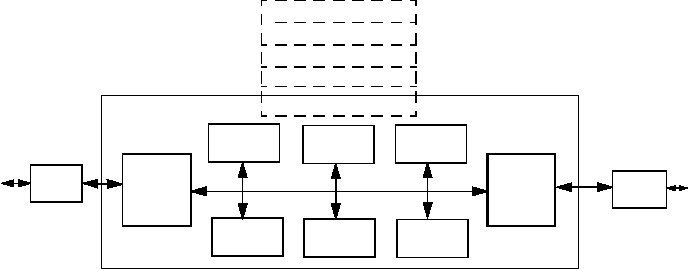© 2000 Ubicom, Inc. All rights reserved.
- 1 -
www.ubicom.com
Ubicom™ and the Ubicom logo are trademarks of Ubicom, Inc.
I2C™ is a trademark of Philips Corporation
.
All other trademarks mentioned in this document are property of their respec-
tive companies.
PRELIMINARY
December 8, 2000
IP2022 Internet ProcessorTM
Features and Performance Optimized for Network Connectivity
1.0 PRODUCT OVERVIEW
1.1 Introduction
The Ubicom IP2022 Internet ProcessorTM combines sup-
port for communication physical layer, Internet protocol
stack, device-specific application and device-specific
peripheral software modules in a single chip, and is
reconfigurable over the Internet. It can be programmed,
and reprogrammed, using pre-built software modules
and configuration tools to create true single-chip solu-
tions for a wide range of device-to-device and device-to-
human communication applications. Fabricated in an
advanced 0.25-micron process, its RISC-based deter-
ministic architecture provides high-speed computation,
flexible I/O control, efficient data manipulation, in-system
programming, and in-system debugging. A hardware full-
duplex serializer/deserializer (SerDes) function gives the
IP2022 the ability to directly connect to a variety of com-
mon network interfaces. This function provides the ability
to implement on-chip 10BaseT Ethernet (MAC and PHY),
USB, and a variety of other fast serial protocols. The
inclusion of two SerDes units facilitate translation from
one format to another, allowing the IP2022 to be used as
a protocol converter. The 100 MHz operating frequency,
with most instructions executing in a single cycle, deliv-
ers the throughput needed for emerging network connec-
tivity applications, and a flash-based program memory
allows both in-system and on-the-fly reprogramming. The
IP2022 implements peripheral, communications and con-
trol functions as software modules (ipModules™), replac-
ing traditional hardware for maximum system design
flexibility. This approach allows rapid, inexpensive prod-
uct design and, when needed, quick and easy reconfigu-
ration to accommodate changes in market needs or
industry standards.
On-chip dedicated hardware also includes a PLL, an 8-
channel 10-bit ADC, general-purpose timers, single-cycle
multiply instruction, analog comparator, user-selectable
multi-level brown-out detector, watchdog timer, low-
power support, multi-source wakeup capability, user-
selectable clock modes, high-current outputs, and 52
general-purpose I/O pins.
A TCP/IP network protocol stack is available, and a vari-
ety of additional software that is necessary to form a
complete end-to-end connectivity solution is being devel-
oped. Tools for developing with and using the IP2022,
including the complete Red Hat GNUPro tools, are avail-
able from leading suppliers.
Figure 1-1. IP2022 Block Diagram
SerDes
I
SerDes
II
Core
Flash
RAM
Timer
PLL
A
DC
IP2022
Customer Application
HTTP
TCP
IP/ICMP
Network Access Layer
Trans-
ceiver
For Bridging
(optional)
Trans-
ceiver
10BaseT
USB
GPSI
SPI
UART
I2C
Etc.

